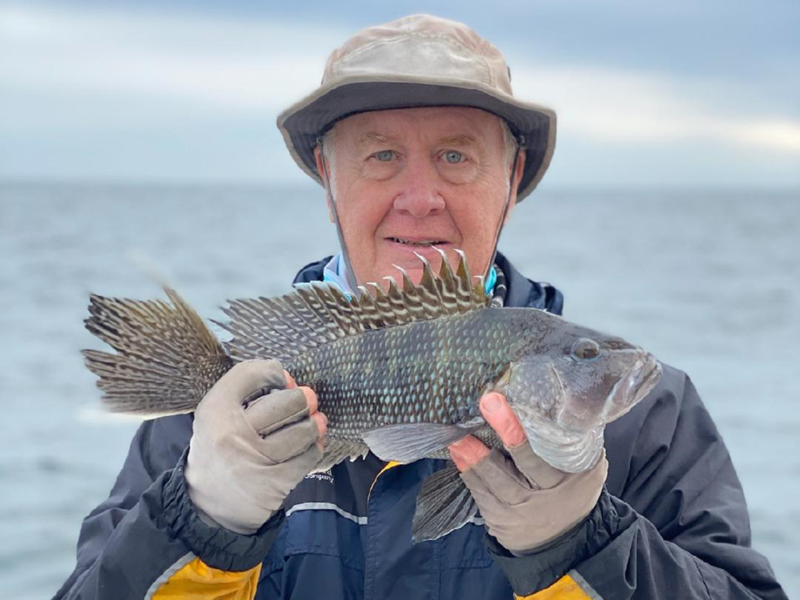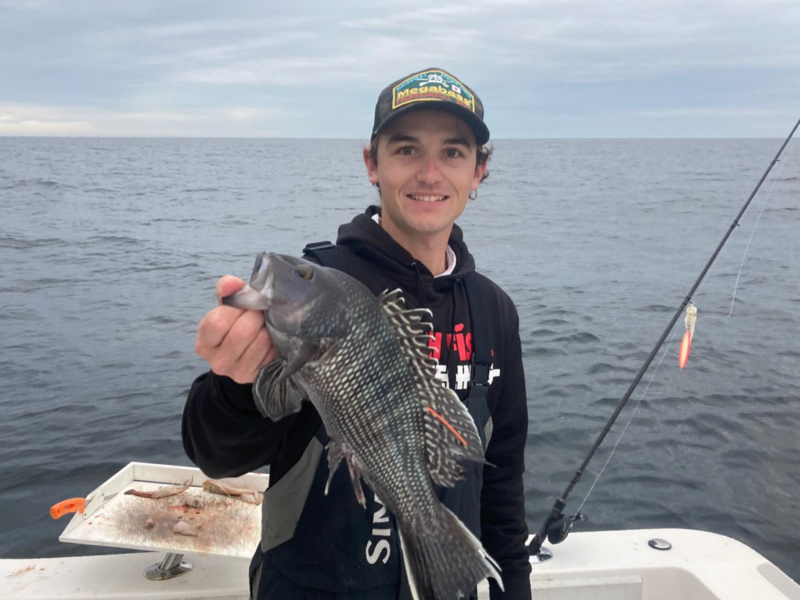My father taught me how to fish, my Uncle Jimmy taught me to love fishing but always had old boats that were somewhat less than reliable, which led to many adventures on the water including the time he took me to the Triangle Wrecks off of Virginia Beach. The Triangle Wrecks consist primarily of four liberty ships and a coast guard cutter. Twenty-seven hundred liberty ships were built and used for transport during World War Two. Many ended up like these, as reefs. Two things I remember about that trip. First, when we got there, Jimmy asked “Do you know where the closest land is?” I looked around and couldn’t see land in any direction, so I replied “No.” He said with a chuckle, “Straight down”.

The second thing I remember about that day were the fish we caught. One type was about the ugliest fish I had ever seen. When the first one came up, I asked “What is that?” He replied “A tautog, that’s what we came for.” At the time I couldn’t figure why anyone would go that far away from land just to catch ugly fish. I have since learned better. We also caught black sea bass that day.
I was thinking about that day when I recently took a trip to the Triangle Wrecks with Captain Stan Gold on his boat Blind Date. Along with us was Drew Camp, a young 20-something kayak and paddle board guru who I have known since he was about four years old, and Kelly Hoggard who drives a boat for Sea Tow and is among other things a really good surf fishing pompano angler.
Our target that day was sea bass, and the fish didn’t disappoint! We ended up catching well over our 15 sea bass apiece limit. Kelly tagged most of the ones we threw back. Drew also scored a nice flounder, a decent puppy drum and a grey trout, all on jigs. We all added a good number of the ever-present spiny dogfish and clear nose skate to the mix.
Stan knew just where to fish. We began at a wreck on the way to the Triangles, where we picked up a good amount of sea bass. Then we left fish to find fish — something that can backfire on you at times — and fished two locations at the Triangles. We stayed busy catching fish everywhere we went.
All About Black Sea Bass
If ever there was a species I both love and hate, it would have to be sea bass. Many of the places I fish in the lower Chesapeake Bay get covered up with juvenile sea bass in the summer. These pesky rascals will hit just about anything with a hook and I often end up throwing back many baby sea bass. Okay, that’s the “hate” part.
On the other hand, I love catching bigger sea bass for the table. By “bigger” I mean fish over 12.5 inches, but especially the larger “hump-backs”. One thing you will notice with sea bass is that as they get larger, they develop a hump behind their head. Most sea bass start out life as females and become male as they mature. By the time they reach a few pounds and develop the hump, they are male.
Sea bass are not particularly picky eaters. Perhaps the easiest approach is to use pieces of cut squid on 3/0 to 5/0 hooks fished on a bottom rig with a sinker. You may also use “free style” jigs or similar lures heavy enough to reach bottom. We usually tip the jig hook with a piece of squid or other cut bait. Other cut bait that we use include pieces of tough fish belly from species like false albacore or cobia.
I prefer conventional reels for this type of fishing. My go-to reel is an Avet SXJ spooled with 20-pound braid, on a six-foot, six-inch medium heavy action rod. We are typically drifting in water from 50 feet to well over 100 feet deep when fishing for sea bass. Occasionally, you will encounter a larger species while wreck fishing. When that happens, you will wish you were using heavier gear. But I prefer the lighter gear since it’s more fun when catching sea bass.
Sea bass definitely love structure. Any wreck or reef is liable to hold them. The trick is to find a spot that hasn’t been fished out recently. One nice thing about fishing the Triangle Wrecks is that there is a lot of structure from multiple wrecks in one area. This allows you to try several locations until you find the fish. Another nice thing about the Triangle is that there are other wrecks and reefs on the way out there. Having said that, this area does receive heavy fishing pressure.
I’m hoping that the Coastal Virginia Offshore Wind Project 27 miles off the coast of Virginia Beach is going to add a lot of new structure for this type of fishing. Two test wind turbines have already been constructed and when finished, this area is projected to have 180 turbines. That is a lot of structure with potential to hold fish.
If you don’t want to go as far as the Triangle Wrecks to find fish, I would suggest more inshore sites such as the Chesapeake Light Tower Reef. There are a few wrecks within just a few miles of this reef that also may hold sea bass. Depending on the time of year, any of these locations may also hold many other species so don’t be surprised to find a variety. Flounder often frequent the same structure as sea bass, especially in the fall and winter. Some folks prefer to pull a flounder rig with a larger strip of cut bait when reef fishing, and larger sea bass will hit these baits, too.

Black sea bass are definitely top shelf seafood. Note that I said, “black sea bass.” You may see Chilean sea bass on restaurant menus, but these are actually Patagonian toothfish, a totally different species. I’ve never found a bad way to prepare sea bass. With flaky, white, mild flavored flesh I like them baked, broiled, fried, or grilled, and they make very good fish tacos.
Sea Bass in Virginia
At last check, in Virginia you are allowed 15 fish over 12.5 inches per angler during open sea bass season. That was May 15 to 31 and June 16 through December 31, but they bite great in cold weather and there’s a “special” February season running all month which you can fish by permit. Just go to the VMRC website via this link to the (free) permit application. Part of obtaining the permit is agreeing to report all trips (and/or lack of fishing activity).
A sea bass over five pounds will earn you a citation from the Virginia Saltwater Fishing Tournament. Of course, the fish must be weighed in at one of their official sites, where you can also submit the paperwork.
- By Chuck Harrison